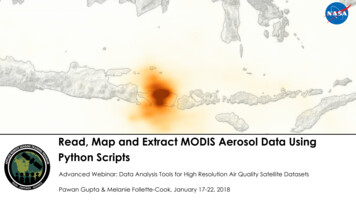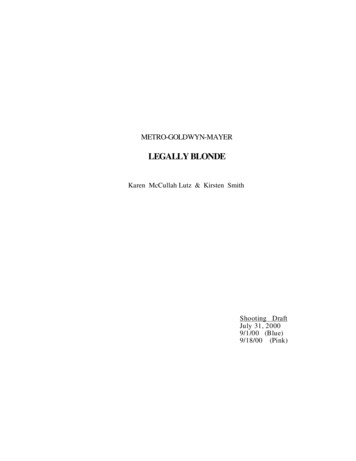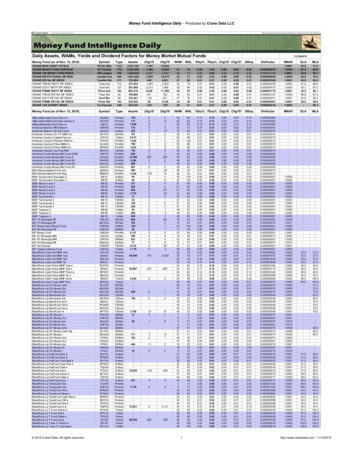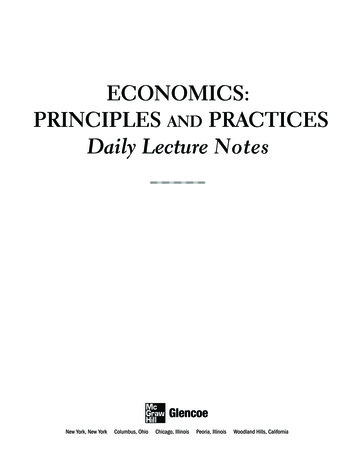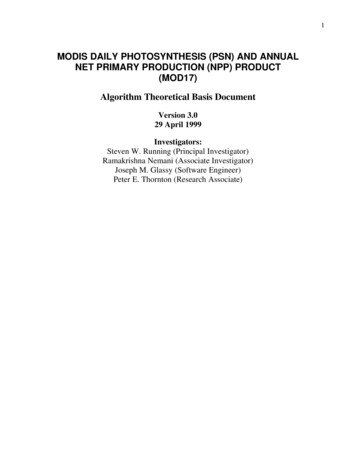
Transcription
1MODIS DAILY PHOTOSYNTHESIS (PSN) AND ANNUALNET PRIMARY PRODUCTION (NPP) PRODUCT(MOD17)Algorithm Theoretical Basis DocumentVersion 3.029 April 1999Investigators:Steven W. Running (Principal Investigator)Ramakrishna Nemani (Associate Investigator)Joseph M. Glassy (Software Engineer)Peter E. Thornton (Research Associate)
2Table of Contents1. Introduction. 41.1 Identification . 41.2 Overview. 42. Theoretical Background . 52.1 Estimating NPP from APAR. 52.2 Relating APAR and surface reflectance . 63. Algorithm Overview. 63.1 Daily estimation of GPP . 73.2 Annual estimation of NPP . 94. BPLUT parameterization. 114.1 Parameterization strategy overview . 114.2 Parameters for daily GPP. 134.2.1 Biome-BGC model overview. 134.2.2 Experimental protocol for global simulations . 154.2.3 Optimal parameter selection. 175. Algorithm Implementation . 175.1 Programming/Procedural Considerations . 185.2 Production Rule Summary . 185.3 Implementation Software Environment. 195.3.1 Software Design . 205.4 Spatial Map Projection Used. 225.5 Data Requirements and Dependencies . 225.5.1 Data Inputs . 245.5.2 Intermediate Daily Inputs to PSN, NPP. 245.5.3 MODIS Daily Inputs. 245.5.4 Ancillary Inputs . 255.6 Compute Loads and Storage Requirements. 275.6.1 CPU Load Calculation Methods. 275.7 PSN, NPP Algorithm Logic . 285.7.1 Daily Calculations. 295.7.2 Methods for computing the 8-day PSN composite. 325.8 Quality Control and Diagnostics . 325.8.1 Post Production Quality Assurance . 335.8.2 Pixel level (spatial) QA. 335.8.3 Assessing Quality of PSN, NPP Products On line . 345.8.4 System Reliability and Integrity Issues. 345.9 Exception Handling . 355.10 Output Products. 365.10.1 The 8-day PSN composite archive product. 375.10.2 Annual Net Primary Productivity (NPP) archive product . 386. Validation Plan. 386.1 Overview of MOD17 (PSN/NPP) validation. 386.1.1 Temporal monitoring – carbon, water and energy fluxes . 396.1.2 Spatial monitoring - Terrestrial vegetation products from EOS . 39
36.1.3 System processes and integration – ecological modeling. 396.2 Global flux tower network (FLUXNET). 406.2.1 Eddy covariance principles . 416.2.2 Implementation and Operation . 416.3 Validation of EOS terrestrial vegetation products . 426.3.1 Vegetation measurements in the EOS/MODIS grid. 426.3.2 Quantifying Land surface heterogeneity for EOS validation - BigFoot. 436.4 System integration and scaling with models. 446.4.1 SVAT model requirements for 1-d flux modeling . 456.4.2 Relating NEE and NPP in the flux tower footprint . 466.4.3 Biospheric model intercomparisons. 476.5 International coordination and implementation . 476.6 Testing MODIS PSN/NPP products in near real-time . 497. References. 54
41. INTRODUCTION1.1 IdentificationParameternumber37162703MODIS Product No. 17 (MOD17)SpatialParameter NameResolutionPhotosynthesis (PSN)1kmNet Primary Production (NPP)1kmTemporalResolution8-dayannual1.2 OverviewProbably the single most fundamental measure of "global change" of practicalinterest to humankind is change in terrestrial biological productivity. Biologicalproductivity is the source of all the food, fiber and fuel that humans survive on, so definesmost fundamentaly the habitability of the Earth.The spatial variability of NPP over the globe is enormous, from about 1000 gC/m2for evergreen tropical rain forests to less than 30 gC/m2 for deserts (Lieth and Whittaker1975). With increased atmospheric CO2 and global climate change, NPP over large areasmay be changing (Myneni et al 1997a, VEMAP 1995, Melillo et al 1993).Understanding regional variability in carbon cyle processes requires adramatically more spatially detailed analysis of global land surface processes. Beginningin summer 1999, the NASA Earth Observing System will produce a regular globalestimate of near-weekly photosynthesis and annual net primary production of the entireterrestrial earth surface at 1km spatial resolution, 150 million cells, each having PSN andNPP computed individually.The PSN and NPP products are designed to provide an accurate, regular measureof the production activity or growth of terrestrial vegetation. These products will haveboth theoretical and practical utility. The theoretical use is primarily for defining theseasonally dynamic terrestrial surface CO2 balance for global carbon cycle studies suchas answering the "missing sink question” of carbon (Tans et al. 1990). The spatial andseasonal dynamics of CO2 flux are also of high interest in global climate modeling,because CO2 is an important greenhouse gas (Keeling et al. 1996, Hunt et al 1996).Currently, global carbon cycle models are being integrated with climate models,towards the goal of integrated Earth Systems Models that will represent the dynamicinteraction between the atmosphere, biosphere and oceans. The weekly PSN product ismost useful for these theoretical CO2 flux questions.The practical utility of these PSN/ NPP products is as a measure of crop yield,range forage and forest production, and other economically and socially significantproducts of vegetation growth. The value of an unbiased, regular source of crop, rangeand forest production estimates for global political and economic decision making isimmense. These products will be available for all users worldwide. This daily computedPSN more correctly defines terrestrial CO2 fluxes than simple NDVI correlationscurrently done to increase understanding on how the seasonal fluxes of netphotosynthesis are related to seasonal variations of atmospheric CO2.
52. THEORETICAL BACKGROUND2.1 Estimating NPP from APARThe notion of a conservative ratio between absorbed photosynthetically activeradiation (APAR) and net primary production (NPP), was proposed by Monteith (1972;1977). Monteith’s original logic suggested that the NPP of well-watered and fertilizedannual crop plants was linearly related to the amount of solar energy they absorbed.APAR depends on the geographic and seasonal variability of daylength and potentialincident radiation, as modified by cloudcover and aerosols, and on the amount andgeometry of displayed leaf material. This logic combined the meteorological constraint ofavailable sunlight reaching a site with the ecological constraint of the amount of leaf-areaabsorbing that solar energy, avoiding many complexities of carbon balance theory.Time integrals of APAR have been shown to correlate well with observed NPP(Asrar et al., 1984; Goward et al., 1985; Landsberg et al., 1996), but differentrelationships are observed for different vegetation types, and for the same vegetation typeunder different growth conditions (Russell et al., 1989). Other factors influencing NPP,in addition to APAR, include: concentration of photosynthetic enzymes (Evans, 1989;Ellsworth and Reich, 1993; Hirose and Werger, 1994; Reich et al., 1994; Reich et al.,1995); canopy structure and average PAR flux density (Russell et al., 1989; Beringer,1994); respiration costs for maintenance and growth (Lavigne and Ryan, 1997; Maier etal., 1998); canopy temperature (Schwarz et al., 1997); evaporative demand (Meinzer etal., 1995; Dang et al., 1997; Pataki et al., 1998); soil water availability (Jackson et al.,1983; Davies and Zhang, 1991; Will and Teskey, 1997); and mineral nutrient availability(Fahey et al., 1985; Aber et al., 1991; Hikosaka et al., 1994). The challenge of estimatingNPP from APAR over a global domain is in accounting for these multiple influences.Although it has been clearly demonstrated that useful empirical relationshipsbetween measured NPP and measured APAR can be derived for individual sites orrelated groups of sites, the objective parameterization of these empirical relationshipsover the global range of climate and vegetation types is a more difficult problem.Monteith’s original formulation included a maximum radiation conversion efficiency(εmax) that was attenuated by the influence of other simple environmental factorspostulated to reduce growth eficiency. The same basic approach has been used in mostother applications of the radiation use efficiency concept, with the most significantdifferences between approaches being the determination of values for εmax and thefunctional forms for its attenuation. Early applications assumed a universal constant forεmax that would apply across vegetation types, but later studies showed importantdifferences in maximum efficiency between types (Russell et al., 1989). It has beenshown that differences in autotrophic respiration costs may account for some of theimportant differences in εmax between vegetation types (Hunt, 1994), which suggests thatAPAR may be more closely related to the gross primary production (GPP) than to NPP(GPP is the photosynthetic gain before any plant respiration costs have been subtracted).This approach, using APAR to predict GPP instead of NPP, and later accounting forrespiration costs through other relationships, has been employed in recent studies (Princeand Goward, 1995). Since the relationships of environmental variables, especiallytemperature, to the processes controlling GPP and those controlling autotrophicrespiration have fundamentally different forms (Schwarz et al., 1997; Maier et al., 1998),
6it seems likely that the empirical parameterization of the influence of temperature onproduction efficiency would be more robust if the gross production and autotrophicrespiration processes were separated. This is the approach we employ in the MOD17algorithm.2.2 Relating APAR and surface reflectanceA strong relationship has been shown to exist for vegetated surfaces between thefractional absorption of incident PAR and the surface reflectance of incident radiation(Sellers, 1987; Asrar et al., 1992). A robust predictive theory for this relationship hasalso been established (Sellers et al., 1992). This relationship makes the radiationconversion efficiency logic an attractive avenue for predicting NPP from remote sensinginputs (Prince, 1991; Potter et al., 1993; Prince and Goward, 1995; Hunt et al., 1996;Veroustraete et al., 1996; Hanan et al., 1997).It is important to note that the radiation use efficiency logic requires an estimateof APAR, while the usual application of remote sensing data provides an estimate ofFPAR, the fraction of incident PAR that is absorbed by the surface (APAR PAR *FPAR). Measurements or estimates of PAR are therefore required in addition to theremotely sensed FPAR. For studies over small spatial domains with in situ measurementof PAR at the surface, the derivation of APAR from satellite-derived FPAR isstraightforward. Implementation of the radiation use efficiency logic for the MODISNPP algorithm depends on global daily estimates of PAR, ideally at the same spatialresolution as the remote sensing inputs, which is a challenging problem. Variousmethods have been implemented to address this problem, and we will consider some ofthem in a later section. For now, we simply note that in spite of the strong theoretical andempirical relationship between remotely sensed surface reflectance and FPAR, accurateestimates of NPP will depend at least as strongly on the quality of the global dailyestimates of PAR.3. ALGORITHM OVERVIEWThis section outlines the logic of the MOD17 PSN/NPP algorithm, addressing thescience issues that have guided its development and implementation. Section 4 addressesthe parameterization of the biome properties lookup table, and Section 5 addresses thedetails of algorithm implementation, focusing on compute structure, data handling,processing loads, and quality assurance issues. Section 6 covers algorithm validationeforts.The essence of the core science in the MOD17 algorithm is an application of theradiation conversion efficiency logic to predictions of daily GPP, using satellite-derivedFPAR (from MOD15) and independent estimates of PAR and other surfacemeteorological fields (from the DAO), and the subsequent estimation of maintenance andgrowth respiration terms that are subtracted from GPP to arrive at annual NPP. Themaintenance respiration (MR) and growth respiration (GR) components are derived fromallometric relationships linking daily biomass and annual growth of plant tissues tosatellite-derived estimates of leaf area index (LAI) from MOD15. These allometricrelationships have been derived from extensive literature review, and incorporate the
7same parameters used in the Biome-BGC ecosystem process model (Running and Hunt,1993, Thornton et al., in prep., White et al., in prep.).The parameters relating APAR to GPP and the parameters relating LAI to MRGR are estimated separately for each unique vegetation type in the at-launch landcoverproduct (MOD12). The GPP parameters are derived empirically from the output ofBiome-BGC simulations performed over a gridded global domain using multiple years ofgridded global daily meteorological observations. The MR and GR parameters are takendirectly from the Biome-BGC ecophysiological parameter lists, which are organized byplant functional type (White et al., in prep.). See Section 4 for a discussion of theparameterization process for GPP and respiration parameters.MOD17 operates over the global set of 1km land pixels, using the combination ofdaily and annual processing just outlined. The discussion of daily and annual processingin the following subsections is with respect to a single 1km land pixel. Details of thetreatment of gridding, tiling, and storage of intermediate variables are presented inSection 5, Algorithm Implementation.3.1 Daily estimation of GPPFor a particular pixel from the global set of 1km land pixels, daily estimatedFPAR from MOD15 and daily estimated PAR from DAO are multiplied to produce dailyAPAR for the pixel. Based on the at-launch landcover product, a set of radiationconversion efficiency parameters are extracted from the biome properties lookup table(BPLUT). There are five such parameters for each vegetation type:Table 3.1 BPLUT parameters for daily GPPparameterunitsdescription-1(kgC MJ )the maximum radiation conversion efficiencyεmaxTMINstart( C)the daily minimum temperature at which ε εmax (foroptimal VPD)TMINfull( C)the daily minimum temperature at which ε 0.0 (at anyVPD)VPDstart(Pa)the daylight average vapor pressure deficit at which ε εmax (for optimal TMIN)VPDfull(Pa)the daylight average vapor pressure deficit at which ε 0.0 (at any TMIN)The two parameters for TMIN and the two parameters for VPD are used tocalculate two scalars that attenuate εmax to produce the final ε used to predict GPP. Theseattenuation scalars are simple linear ramp functions of daily TMIN and VPD, asillustrated for TMIN in the following figure:TMIN scalar1.00.0TMIN fullTMIN start
8The final estimation of daily GPP is illustrated in the top panel of Figure 3.1, below.ε maxPhotosynthesisTmin, VPDPARFPARGPPMaintenance Respiration-Q10, TavgMRMRindexDailyNPP*Rnetfine rootmassLAIεxSLAallometryleaf massMOD-17Daily NPP**does not include growth respiration orlive wood maintenance respiration costsleafmassDaily OutputsFigure 3.1 This flowchart illustrates data flow in the daily part of the MOD17 algorithm. Outputvariables are shown at the bottom, where the notation NPP* indicates that not all of the autotrophicrespiration terms have been subtracted. The remaining terms required to produce actual NPP arehandled in the annual timestep.The second step of the daily process is to estimate maintenance respiration costsfor leaves and fine roots. These estimates are based on a standard exponential function ofdaily average air temperature (Sprugel et al., 1995; Ryan et al., 1997; Maier et al., 1998),scaled by the biomass of leaves and fine roots. We use LAI from MOD15 to estimateleaf mass, based on a specific leaf area (SLA) from the BPLUT. Fine root mass isassumed to be present in a constant ratio to leaf mass. This process is illustrated in thecenter panel of Figure 3.1. The following parameters from the BPLUT are required forthese calculations:Table 3.2 BPLUT parameters for daily MRparameterunitsdescriptionSLA(m2 kgC-1)projected leaf area p
meteorological fields (from the DAO), and the subsequent estimation of maintenance and growth respiration terms that are subtracted from GPP to arrive at annual NPP. The maintenance respiration (MR) and growth respiration (GR) components are derived from allometric relationships li
